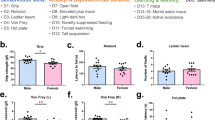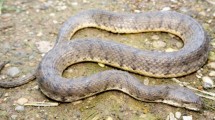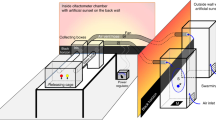She-male garter snakes exploit the amorous attentions of other males to warm up.
Abstract
Males of several animal species mimic females either in appearance or in the chemical cues they release1,2, and this mimicry has generally been interpreted in terms of alternative mating strategies –– for example, a male that mimics a female may obtain stolen inseminations or avoid aggression from larger rivals3. Our studies of snakes suggest a different explanation, which relies on natural selection rather than sexual selection. Male garter snakes that produce female-like pheromones (she-males) may benefit simply because large 'mating balls' of amorous males form around them, transferring heat to the she-male after it emerges from hibernation and reducing its exposure to predators.
This is a preview of subscription content, access via your institution
Access options
Subscribe to this journal
Receive 51 print issues and online access
$199.00 per year
only $3.90 per issue
Buy this article
- Purchase on SpringerLink
- Instant access to full article PDF
Prices may be subject to local taxes which are calculated during checkout

Similar content being viewed by others
References
Andersson, M. Sexual Selection (Princeton Univ. Press, Princeton, New Jersey, 1994).
Mason, R. T. & Crews, D. Nature 316, 59–60 (1985).
Trivers, R. L. Evolution 30, 253–269 (1976).
Shine, R., Harlow, P. S., LeMaster, M. P., Moore, I. & Mason, R. T. Anim. Behav. 59, 349–359 (2000).
Shine, R., O'Connor, D. & Mason, R. T. Can. J. Zool. 78, 1391–1396 (2000).
Shine, R., LeMaster, M. P., Moore, I. T., Olsson, M. M. & Mason, R. T. Evolution 55, 598–604 (2001).
Olson, D. H. Copeia 1989, 391–397 (1989).
Hamilton, W. D. J. Theor. Biol. 31, 295–311 (1971).
Whittier, J. M., Mason, R. T. & Crews, D. Behav. Ecol. Sociobiol. 16, 257–261 (1985).
Shine, R., Harlow, P. S., Elphick, M. J., Olsson, M. M. & Mason, R. T. Physiol. Biochem. Zool. 73, 508–516 (2000).
Heckrotte, C. Copeia 1967, 759–763 (1967).
Author information
Authors and Affiliations
Corresponding author
Additional information
Competing financial interests: declared none.
Rights and permissions
About this article
Cite this article
Shine, R., Phillips, B., Waye, H. et al. Benefits of female mimicry in snakes. Nature 414, 267 (2001). https://doi.org/10.1038/35104687
Issue date:
DOI: https://doi.org/10.1038/35104687
This article is cited by
-
Toward an understanding of the chemical ecology of alternative reproductive tactics in the bulb mite (Rhizoglyphus robini)
BMC Ecology and Evolution (2022)
-
Ontogenetic colour change of a sexual ornament in males of a damselfly: female mimicry, crypsis or both?
The Science of Nature (2022)
-
Let's talk about sex
Nature (2012)
-
Facultative pheromonal mimicry in snakes: “she-males” attract courtship only when it is useful
Behavioral Ecology and Sociobiology (2012)
-
Social behavior and pheromonal communication in reptiles
Journal of Comparative Physiology A (2010)



